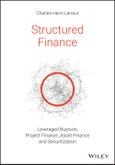Comprehensive coverage of all major structured finance transactions
Structured Finance is a comprehensive introduction to non-recourse financing techniques and asset-based lending. It provides a detailed overview of leveraged buyouts, project finance, asset finance and securitisation.
Through thirteen case studies and more than 500 examples of companies, the book offers an in-depth analysis of the topic. It also provides a historical perspective of these structures, revealing how and why they were initially created. Instruments within each type of transaction are examined in detail, including Credit Default Swaps and Credit Linked Notes. A presentation of the Basel Accords offers the necessary background to understand the regulatory context in which these financings operate.
With this book, readers will be able to:
- Delve into the main structured finance techniques to understand their components, mechanisms and how they compare
- Understand how structured finance came to be, and why it continues to be successful in the modern markets
- Learn the characteristics of financial instruments found in various structured transactions
- Explore the global context of structured finance, including the regulatory framework under which it operates
Structured Finance provides foundational knowledge and global perspective to facilitate a comprehensive understanding of this critical aspect of modern finance. It is a must-read for undergraduate and MBA students and finance professionals alike.
Table of Contents
Preface xix
Introduction 1
A Brief History of Structured Finance 1
Defining Structured Finance 4
Why was Structured Finance Set Up? 6
PART I Leveraged Buyout (LBO) 13
CHAPTER 1 What is an LBO? 15
1.1 The Main Features of an LBO 15
1.2 A Three-step Leverage 17
Case Study 1: The Harley-Davidson LBO (1981-1986) 22
CHAPTER 2 The Different Stakeholders 26
2.1 The Target Company 26
2.2 Buyers 35
2.3 Lenders 40
Case Study 2: Michael Milken and the Birth of the High-Yield Bond Market 47
Case Study 3: Malcolm Glazer and the Manchester United LBO 53
CHAPTER 3 The LBO Process 63
3.1 The Sale Process 63
3.2 Exit Strategies 72
3.3 LBO and Private Equity 77
Case Study 4: Hilton Hotels LBO, the Most Profitable Private Equity Deal Ever 85
Summary LBOs: What Have We Learnt? 92
PART II Project Finance 95
CHAPTER 4 The ABC of Project Finance 97
4.1 Definition 97
4.2 Why Choose a Project Finance Structure 99
4.3 Constraints of the Project Finance Structure 103
4.4 How to Choose between Corporate and Project Financing 103
Case Study 5: The Construction of the Eiffel Tower 105
CHAPTER 5 The Main Parties to Project Financing 110
5.1 Different Types of Projects 110
5.2 Sponsors 117
5.3 Lenders 127
5.4 The Role of Public Authorities 140
Case Study 6: The Near Bankruptcy of Disneyland Paris 142
CHAPTER 6 Project Finance Structuring 149
6.1 Preliminary Analysis of the Project 149
6.2 Project Finance Legal Structure 156
6.3 Financial Structure 166
Summary Project Finance: What Have We Learnt? 173
PART III Asset Finance 175
CHAPTER 7 Definition of Asset Finance 177
7.1 The Scope of Asset Finance 177
7.2 How to Finance Assets 178
Case Study 7: Richard Branson and the Beginnings of Virgin Atlantic 196
CHAPTER 8 The Stakeholders 200
8.1 Clients 200
8.2 Lessors 210
8.3 Lenders 222
Case Study 8: The Rise and Fall of GPA Group, the First Giant Aircraft Leasing Company 230
CHAPTER 9 Behind the Scenes 238
9.1 Inside a Leasing Company 238
9.2 Legal Considerations 243
9.3 The Dynamics of Leasing Markets 250
Summary Asset Finance: What Have We Learnt? 254
PART IV Securitization 255
CHAPTER 10 The Securitization Process 257
10.1 Transforming Illiquid Assets into Liquid Securities 257
10.2 Tranching of Securities 258
Case Study 9: The Securitization of David Bowie's Intellectual Property Rights 264
Case Study 10: What is a Covered Bond? 267
CHAPTER 11 The Different Stakeholders 272
11.1 Borrowers 272
11.2 The Originator 274
11.3 Around the SPV: The Transaction's Life 276
11.4 The Investors 280
Case Study 11: The Subprime Crisis 285
Case Study 12: Michael Burry's Big Short 294
CHAPTER 12 Structuring a Securitization 299
12.1 Composition of the Collateral 299
12.2 Managed Transactions 302
12.3 Additional Structuring Considerations 311
Case Study 13: Whole Business Securitization 324
Summary Securitization: What Have We Learnt? 327
Conclusion 329
Structured Finance: What Have We Learnt? 329
A Comparison of Various Types of Structured Finance 330
What is the Future for Structured Finance? 332
Appendix A How Banks Set Interest Rates 336
Appendix B Syndication and Club Deals 341
Appendix C Credit Derivatives 347
Bibliography 350
Acknowledgments 354
Index 357








